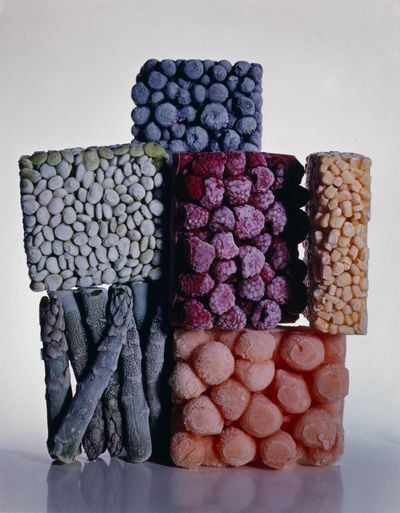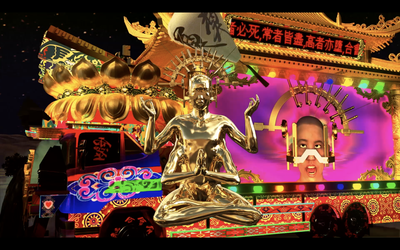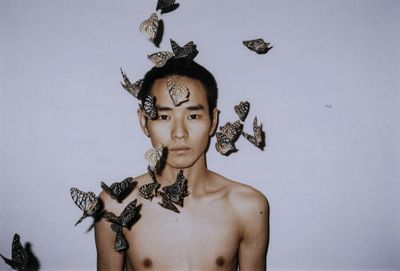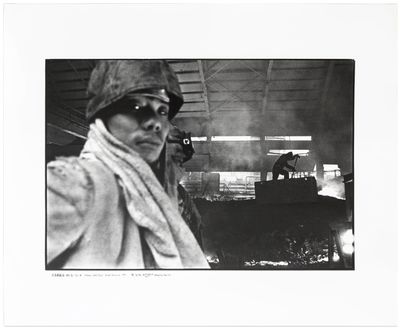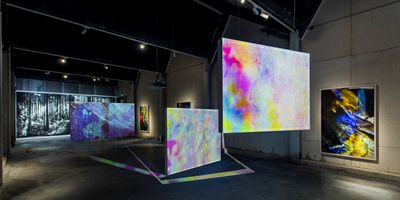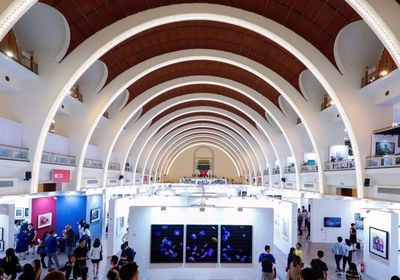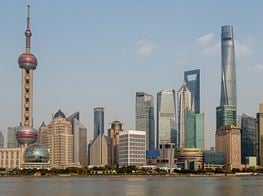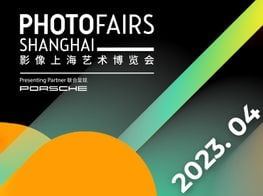Expanded Vocabularies: PHOTOFAIRS | Shanghai 2017

Installation view: PHOTOFAIRS | Shanghai, Shanghai (8–10 September 2017). Courtesy PHOTOFAIRS.
Ten years ago, when I was but a new addition to Hong Kong's small but burgeoning community of gallerinas, I was hard pressed to sell an editioned photo print to Chinese collectors. People worried about edition numbers and the investment potential of something that had multiple prints.
Visitors came to the gallery to take photos of the photos, arguing that purchasing a print was no longer necessary now they could print their own copy from the camera. Things have certainly moved on since then. Chinese collectors are snapping up photography, contemporary Chinese photographers are making their mark in the international market, and Shanghai boasts its own photography fair.
Formerly known as Photo Shanghai, PHOTOFAIRS | Shanghai is, as the name suggests, dedicated to the curated presentation of photography and moving image, and the only art fair of its kind in the country. This year, the fair's fourth edition included 50 participating galleries from 16 countries and 28 cities, from Amsterdam to Tehran (8–10 September 2017). It was held in the Shanghai Exhibition Center, a salmon pink wedding cake of Empire style neoclassicism, Stalinist chic and Disney, built in 1955 to commemorate the Sino-Soviet alliance.
A row of colourful glossy Porsches placed in a branded cube greet visitors before one even entered the exhibition centre, with more corporate sponsorship inside. Before arriving at the main exhibition hall, visitors had to elbow their way through a luxury maze of sponsor exhibitions—a large Leica show, a Lancôme installation promising eternal youth in a bottle. (Fairs are expensive affairs to produce.)
The PHOTOFAIRS | Shanghai format includes several sections and features. Insights, launched last year in Shanghai and will go to the fair's San Francisco edition with a different theme, presented a focused section of unique one-off works by 19 photographers this year.
The sector, curated by the fair's artistic director Alexander Montague-Sparey, traced colour photography from the mid–1970s to now, beginning with the experimental dye transfer prints of William Eggleston, and works by masters Harold Edgerton, Daido Moriyama (who along with Nobuyoshi Araki popped up with frequency throughout the fair), and Harry Callahan, shown alongside younger contemporary photographers like Wu Ding, Jiang Pengyi, Vik Muniz, and Robert Zhao Renhui.
'We've found a huge appetite for photography here. Photography is at an accessible price point.'
Polaroid transfers by Hunan-born Jiang Pengyi, which derived from pornographic imagery, could also be found here. (I hosted a public Conversation with the artist later in the week, discussing Georges Bataille's l'érotisme, sex and death, taboo, and porn—fun stuff for censors on a Saturday afternoon.)
On the need for a sector like Insights, PHOTOFAIRS | Shanghai director Sarah Shepard says: 'It's important for us to have an exhibition with museum quality artworks. We've had to educate people on collection and editions, which is why we have Insights section. These are unique prints. We need to show in China that photography is collectible, and by institutions too.'
To that end, the fair also featured institutions like the Centre for Contemporary Photography (Melbourne), Museum of Photography (Seoul), OCAT (Xi'an), and Maison Européenne de la Photographie (Paris). There was also a special Collector's exhibition, set under the venue's gold-gilt Fabergé egg dome ceiling—a curated insight into the private acquisitions of top art collectors David Chau (Cc Foundation), Adrian Cheng (K11 Art Foundation), Thomas Shao (Modern Media Group), and Jenny Wang (Fosun Foundation), with works by Chen Wei, Yang Fudong and Chen Xiaoyun.
The main hall, where the majority of booths were to be found, included Shanghai gallerist and regular international fair circuit participant, Leo Xu, a new addition to Photofairs this year, who exhibited a humorous series by Pixy Liao documenting her daily life with her partner, and touching on Chinese immigrant life in New York. Another fair circuit regular, Tokyo's Taka Ishii Gallery, mounted an impressive salon hang of Japanese photographers Daido Moriyama, and Nobuyoshi Araki, among others.
Black and white photography—both contemporary and historical—dominated. And while there was a vintage Irving Penn on display at Robert Mann Gallery (Titled Frozen Foods, 1977), it was the most expensive work at the fair at USD 200,000), overall there was a surprising dearth of the usual fashion photography, vintage Cartier-Bresson prints, and Candida Höfer's one comes to expect of these fairs. 'Year one was a lot of fashion photography. It was an easy route for collectors. Now we have more video and experimental work', one representative commented.
The vocabulary of photography was expanded in the Staged sector, which explored the relationship between photography and other mediums such as installation, digital media and film. A large black and white collage installation from artistic duo Birdhead, Welcome to Birdhead Again 2016-02 (2016), towered at the entrance of the hall; presented by ShanghART Gallery, it documents the duo's experience of daily life in Shanghai.
OCAT (Xi'an) presented digitally printed textile and fashion, and Rubber Factory from New York showed textile-based photography by Jordan Sullivan. The artist printed durational landscape photos of the desert on silk, crushing and destroying the image so that the result looked like abstract watercolours. ('I wanted to make a sculptural photo you could walk around—a photo not constrained by traditional prints', explains Sullivan.)
The relationship between video and photography was further explored in Shanghainese artist Lu Yang's Interactive Hearse (2017), a video commissioned by Daata Editions, which presents 'a death portrait as a living animation, with the imagined dead artist's face smiling at you on both sides of hearses LED screen'.
There were works by Ren Hang featured in the Spotlight section, which explores the critical and commercial standing of key contemporary photographers. The first major exhibition of the artist's work since his death in February, 19 pieces previously seen at the KWM artcenter in Beijing (in the exhibition Beauty without Beards (19 January–24 March 2017) were presented by the centre at the fair—the last to have been authenticated by the artist before his death.
It was a more subdued—some would argue watered down—selection compared to the iconic works that made Ren a star and pariah of the censors. KWM assistant director, Tim Crowley explains that, 'Ren's work wasn't just about sexuality, although of course there was that too. He focused on issues that any other 20-something-year-old was grappling with—finding their place in the world, identity'.
Inspired by Greek sculptures of the male nude, the series features young men at play in nature—climbing trees, playing with kittens, hiding behind flowers.
In general, there was an impressive representation of historical works by Chinese photographers. Three Shadows +3 Gallery, founded by photographers RongRong (who in 1994 co-founded the first Chinese conceptual art photography magazine New Photo) and Inri, exhibited elegant black and white works by Wang Wusheng that resembled Chinese ink on paper landscapes, including a small photo of Mount Huangshan from 1991 (USD 83,900).
These were presented alongside a series of black and white street photography prints by 23-year-old emerging photographer Liang Xiu, the recipient of the 2017 Three Shadows Photography award. Hong Kong photographer Jeff Lam Pok Yin and Chong Ng a pair of young photographers creating work centered around analogue photographic process, presented a series based On Kawara's clock.
At Hong Kong's Blindspot Gallery, Zhang Hai'er showed a solo presentation of his black and white street photography from the 1980s and 90s, and photos of his muse and wife, Hu Yuanli.
The artist had a solo presentation of his work at the Shanghai Center of Photography in West Bund, to which we paid a visit. Seated beside the photographer and his wife at a lunch in contemporary Chinese art star Ding Yi's studio, Hai'er explained that despite having worked in Paris, he always preferred working in China. 'I like pushing against and working against something, against comfort and working with the challenges here', he said.
Pulitzer Prize winning photojournalist, Liu Heung Shing, who was present in the booth at Nong Art (Shanghai), showed his Communist-era documentary series including an iconic 1981 Forbidden City photograph of a young man with a bottle of Coca Cola (USD 50,000). First visiting China in 1976 to cover Mao Zedong's funeral for Time Magazine, the Hong Kong born photographer has been documenting China's social and economic transformation for over three decades.
Liu is also the founder of the Shanghai Center of Photography, a space dedicated to the staging of focused and curated photographic exhibitions which opened to the public in 2015. In its two years of operation it has already presented 12 exhibitions.
There have been dozens of privately owned and funded institutions sprouting up in China—an estimated 2,000 museums being built between 2000 and 2012—with many in Shanghai, including the Long Museum and Yuz Museum, cited as evidence of the shift of the cultural centre from Beijing to Shanghai. These museums, some trophies of a 'plutocratic culture industry' others more serious curated endeavors, also opened exhibitions during the fair week.
Collector Qiao Zhibing's Tank Project Space in West Bund—yet to be completed but operating as a project space—was showing the works of American artist Matt Saunders, who was also on site for the opening of his first solo exhibition in China. Also in West Bund, The New Century Art Foundation, co-founded by collectors Wang Bing and Xue Bing, mounted a group show with works by Dominique Gonzalez-Foerster, Philippe Parreno and Anri Sala, spanning three decades at Pond Society.
Following Thursday's fair vernissage we headed to Shang Xia, the Hermès-backed Chinese luxury lifestyle brand, to see fashion photography star Chen Man's latest exhibition, and collection of Benedictine monk-inspired cloaks. In the courtyard, women dressed as cats in latex and wearing aforementioned hoods were striking poses on platforms to a DJ mix of beats and meows—a surreal hybrid of Hello Kitty and The Name of the Rose. (What's a fair without an art party, and more luxury brands?)
Back at my hotel that night, I walked into a scene straight out of Zoolander in a lift full of really, really, ridiculously good-looking men. It was the coterie of the preternaturally youthful and shiny David LaChapelle, who was in town for his exhibition opening at Pearl Lam Gallery. There would be more parties afoot, I could tell by the overpowering scent of Tom Ford's Oud Wood and the number of unbuttoned shirts revealing tanned waxed chests.
As I raided my mini bar for crisps—a vegetarian dinner substitute after an evening of picking pork out of buns—I received a slew of video messages of what looked and sounded like an Alicia Keyes impersonator singing in a mall that I believed to be somewhere on the other side of town.
The thought of getting dressed again and making my way across town in another hour of Shanghai traffic filled me with more dread than the prospect of trying to access Ai Weiwei videos without a VPN. I stayed in my hotel adding friends to my new WeChat account, as instructed by Zhang Hai'er. Turns out the performer was in fact Alicia Keys. The pop star was in town for a fashion party... next door to my hotel.
There was no time for FOMO as it would be another early morning with the PHOTOFAIRS | Shanghai collectors' party bus to visit Antony Gormley's new exhibition, Still Moving, at Long Museum (9 September–26 November 2017). The core of the exhibition, Critical Mass II (1995), is an installation of 60 life-sized cast iron body forms interacting with the modern brutalist architecture of the museum—a former wharf for coal transportation.
Figures are suspended from the vaulted concrete ceilings, they lean against walls and dot and line the floor of the massive space. Showing us through the exhibition, Gormley described the show as a meditation on human nature and the failure of modernism. (It was a powerful visual manifestation of W.G. Sebald's 'Landscapes of Memory'.)
The art market has certainly boomed in China in the past decade. China is the second largest art market in the world, and according to Artprice it still accounts for just 1.2% of photography turnover.
PHOTOFAIRS | Shanghai's presence and the attendance level over the three-day event, which reached a record number of over 30,000 visitors this year, indicates that interest in photography in China is also certainly burgeoning. As Shepard, explains: 'We've found a huge appetite for photography here. Photography is at an accessible price point.' —[O]


